Nick Usborne's Blog, page 19
October 2, 2015
If a business isn’t social, it has no business on social media.
 Let’s say you’re not a very social person. Antisocial even.
Let’s say you’re not a very social person. Antisocial even.
When you go to a local bar, you don’t talk to anyone. And people rarely talk to you because, well, you give off a vibe that you’re not interested in listening to them.
It doesn’t mean you’re a bad person. Doesn’t even mean you don’t like people. It just means you’re not social. So people leave you alone.
Now let’s say you do have one friend, and that friend suggests you try a different bar. It seems this second bar is a really, really social place. Your friend thinks it might change things for you.
So you go to the second bar, and you don’t talk to anyone. They get that same vibe of yours and leave you alone.
The point being, in spite of his or her good intentions, your friend should have known that a change in bars wouldn’t make any difference.
If you’re not a social person, being in a “really, really social place” won’t make a difference.
I see the same story playing out with companies and social media. All the time.
If a company doesn’t have a culture that is naturally social, it doesn’t matter whether they’re on Facebook, Instagram, Twitter, YouTube or anywhere else.
A company that isn’t social won’t get into conversations with their customers and prospects. And their customers and prospects get the same “stay away” vibe.
You can tell which companies these are, because they use their social media platforms as broadcast channels. They’re not there to talk or listen to their friends or followers. They are there simply to tell them about their latest product launch, event or offer.
People figure this out and stop following them, or unfriend them.
Then the company turns around and says, “Social media doesn’t work! It’s a waste of money!”
Social media isn’t the problem here. It’s the antisocial companies that are the problem.
I was reading recently that Nestle is moving all the websites for its instant coffee brand, Nescafe, over to Tumblr.
Their thinking is that that Tumblr is a really, really social place, compared to a tradition website platform.
Therefore, their thinking goes, they’ll get a lot more social traction happening with their younger customers and prospects.
Hmmm…we’ll see.
If the transition from traditional platform over to the Tumblr platform takes place with no change in the social culture of the company itself, I bet it won’t make any difference at all.
They’ll look like some guy in his fifties dropping into a teenage party, hoping young people will suddenly think he’s really cool.
As always, problems like these represent an opportunity.
When a company asks me for help with social media, the first thing I talk about is the social culture within their own company. Not every company likes me asking that question, and sometimes I don’t get the gig.
But when I do get the gig, it gets really interesting. Before I even start on what they might do with social media, I get to talk with them about ways to loosen up internally and develop a more open and social culture that makes for a better fit with social media and, more broadly, social marketing as a whole.
I’m writing about this because I keep coming across posts and articles that tell me social media is dead.
That’s nonsense.
Social media is only dead to those companies that don’t understand it.
In fact, it’s the companies that don’t understand social media that are dead, or getting there.
The future of marketing is social and mobile. And all those companies that whine about social media had better get with the program.
Or they’ll find themselves in the corner of that bar, nursing their fifth drink, and wondering why nobody likes them.
Related:

How to Make Money as a Social Media Marketing Expert
This is the definitive guide to using social media marketing to generate multiple streams of income for yourself and your clients.
As a freelancer you are in a unique position to make money by offering social media consulting and writing services to your clients.
You’ll also learn how to use social media to promote your own business and websites.
This is a huge opportunity for you…right now.
Learn more about How to Make Money as a Social Media Marketing Expert…
About the author: Nick Usborne is an online writer, copywriter, author and coach. Read more…
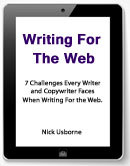
If you found this post helpful, sign up for my e-newsletter and get a free copy of my 35-page guide…
Writing For The Web #1 — 7 Challenges every Writer and Copywriter faces when writing for the Web.
Sign up and I’ll send you the link for the download, and then you’ll receive my most recent post as part of my e-newsletter every Tuesday morning.
Sign Up for my Excess Voice Newsletter…
Name:
Email:
0 subscribers
We respect your privacy
Email Marketing by GetResponse
(Your email address will be used only for the purpose of sending you this newsletter, and you’ll be free to unsubscribe at any time.)
The post If a business isn’t social, it has no business on social media. appeared first on Writing for the web - online copywriting and content writing..
September 25, 2015
Choose clients that inspire your very best work.
 If you look back over the work you have done as a freelance writer or copywriter over the last year, you can probably identify one or two jobs that stand out from the rest.
If you look back over the work you have done as a freelance writer or copywriter over the last year, you can probably identify one or two jobs that stand out from the rest.
These were jobs that brought out the best in you.
They tapped into your core skills.
They allowed you to shine in ways that just didn’t happen with most other projects.
You probably loved the product or service you were promoting.
You respected the company you were working with.
The relationship with the client was probably really good too. Your saw eye to eye. There was mutual respect. They listened to you and allowed you to give expression to your true talents.
The project was FUN to work on.
Ring any bells?
If so, grab a sheet of paper and make a list of what made working with that company so rewarding. Create a checklist.
And put a big fat asterisk next to the line where you describe the kind of project it was. What kind of work brings out the best in you? What are you really, really good at? What enables you to express your true talents?
Now write down two simple descriptions:
1. The kind of project that brings out the best in you.
2. The kind of company you love to work with.
That’s step one. In a way, that’s the easy part.
Step two is to make a commitment to yourself. Commit to ONLY working on those kinds of projects for those kinds of companies.
In other words, commit to working ONLY on projects that bring out the best in you.
Commit ONLY to projects that you really WANT to do.
And say NO to the rest.
Sounds scary, right?
I get that. I struggle with the same thing. I try to work only on the projects I’ll really enjoy…but sometimes the cash-flow monkey hunkers down on my shoulders and tells me to just grab anything that comes my way.
Sometimes I give in. And regret it.
I ask myself, “If I hadn’t spent all those hours on a project I didn’t want to take on, couldn’t I have used that time to find a higher paying gig that would have better suited my core talents as a writer and marketer?”
The answer is almost always YES.
And here’s the thing…
When you only work on projects that truly let you shine, everything gets better.
You feel better when you get up in the morning.
You look forward to your work day.
You do great work every day, and that FEELS GOOD.
Next, you make a name for yourself because ALL your work is really good.
And that means you can charge more and get bigger and better projects.
Before you know it you’re feeding your core talents every day. You feel more fulfilled. You feel you are contributing more.
Hey, you’ll probably smile more too!
All this simply because you are focusing on the kind of work you WANT to do. The kind of work you love. The kind of work that allows you to shine.
And the starting point is to down those two simple descriptions:
1. The kind of project that brings out the best in you.
2. The kind of company you love to work with.
Get to work on that now and find the gigs that inspire you to do your very best work.
Related…

Marketing Confidence – Because self-confidence is the number one driver of success for freelancers.
This program is my “coaching in a box” course for freelancers.
While covering every aspect of building your freelance business, and growing your income, its core value is in helping you increase your level of self-confidence as you approach and work with clients.
Learn more about Marketing Confidence…
About the author: Nick Usborne is an online writer, copywriter, author and coach. Read more…

If you found this post helpful, sign up for my e-newsletter and get a free copy of my 35-page guide…
Writing For The Web #1 — 7 Challenges every Writer and Copywriter faces when writing for the Web.
Sign up and I’ll send you the link for the download, and then you’ll receive my most recent post as part of my e-newsletter every Tuesday morning.
Sign Up for my Excess Voice Newsletter…
Name:
Email:
0 subscribers
We respect your privacy
Email Marketing by GetResponse
(Your email address will be used only for the purpose of sending you this newsletter, and you’ll be free to unsubscribe at any time.)
The post Choose clients that inspire your very best work. appeared first on Writing for the web - online copywriting and content writing..
September 2, 2015
Freelancers – Do you give yourself time to sit back and think?
 As freelancers we like to keep busy.
As freelancers we like to keep busy.
In fact, if we’re not busy we start to feel nervous. After all, “empty” time is unbillable time.
Beyond that, sitting around and doing nothing is something we have always been told is bad.
Staring out of the window and daydreaming at school was bad.
Failing to keep your head down and looking busy as an employee was bad.
From an early age we have been conditioned to believe that during our work hours we should always keep busy. To do otherwise brands us as slackers.
As someone early on in your freelance career, this might mean filling the empty spaces between billable hours with time spent on updating your LinkedIn profile, sending out tweets, reading more articles and posts, downloading and reading more PDFs…and so on.
As an experienced freelancer, you might do the same as the newbies, but you might also take on one or two extra clients, just to be on the safe side. To fill the gaps in your week. To make sure you are always busy.
I know freelancers who have filled every spare hour with projects from truly horrible clients, just so they could say they were always busy.
To admit that we aren’t busy all the time is almost…well, it’s almost admitting we are failures.
I get it. Been there.
But it’s a bad way to work.
To be successful and happy as a freelancer, you should do the opposite.
You should welcome “empty time”. In fact, you should schedule for it. Create it. Insist on it.
Why? Because this empty time isn’t empty at all. It’s the time you take to think about your business. To think about your work and the clients you are working with.
Think about whether you are working with the right kinds of clients – clients who can help and inspire you to do the kind of work that makes you shine, and smile.
This empty time is the time you use to plan, to strategize.
You need this time to give you space to think. To daydream even.
If you don’t, you’ll get stuck in a rut. You’ll be busy all the time, often working on projects you don’t enjoy. Your life will be no different from that of an employee stuck in a cubicle and feeling miserable from 9 to 5.
My advice is to carve out some free time each week. Each day even.
Use this time to think.
Turn off your phone and computer. Turn off and tune out of the daily schedule. Create a little distance.
Think about a future that allows you to do your very best work. Think about the kinds of clients and projects that will bring out the best in you. Improve you. Stretch you. Delight you.
Success isn’t about being busy every minute of the day.
Success is about doing work that gets you out of bed each morning with a smile on your face.
And to get there, you need to clear away some of the clutter and noise, give yourself space to think, and plan for a better future.
Related…

Marketing Confidence – Because self-confidence is the number one driver of success for freelancers.
This program is my “coaching in a box” course for freelancers.
While covering every aspect of building your freelance business, and growing your income, its core value is in helping you increase your level of self-confidence as you approach and work with clients.
Learn more about Marketing Confidence…
About the author: Nick Usborne is an online writer, copywriter, author and coach. Read more…

If you found this post helpful, sign up for my e-newsletter and get a free copy of my 35-page guide…
Writing For The Web #1 — 7 Challenges every Writer and Copywriter faces when writing for the Web.
Sign up and I’ll send you the link for the download, and then you’ll receive my most recent post as part of my e-newsletter every Tuesday morning.
Sign Up for my Excess Voice Newsletter…
Name:
Email:
0 subscribers
We respect your privacy
Email Marketing by GetResponse
(Your email address will be used only for the purpose of sending you this newsletter, and you’ll be free to unsubscribe at any time.)
The post Freelancers – Do you give yourself time to sit back and think? appeared first on Writing for the web - online copywriting and content writing..
August 16, 2015
Good copywriting is good writing.
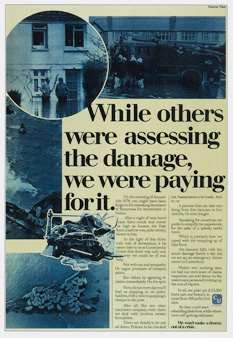 I had lunch with a colleague last week.
I had lunch with a colleague last week.
Like me, he comes from an ad agency background from way back.
We have the same opinions about a few aspects of advertising and copywriting.
First, we both get hugely irritated by bad advertising. We hate blunt, clumsy ads and blunt, clumsy copywriting.
And we both agree that really good copywriting is also really good writing.
That shared opinion led me to tell him the story I share in my live talks about copywriting. It’s about a series of ads written for an insurance company in the UK back in the 1970s. The company was Commercial Union and the copywriter was Susie Henry.
Reading her ads is a joy. She followed advertising legend Bill Bernbach’s philosophy that “good taste, good art, and good writing can be good selling”.
Her copy style was also conversational…it was “across the kitchen table” copywriting. In that sense she anticipated the more conversational style of writing for the web.
But the thing that stands out about her copywriting is that she is a fantastic writer.
Read a good sonnet, read a great novel and read one of her ads.
You’ll notice the same qualities in each. The flow and pace of the writing. The rhythm of the reading experience. The pleasure of reading every word from the beginning to the end.
It doesn’t feel like copywriting at all. It just feels like great writing.
That’s one end of the spectrum of copywriting and, sadly, it seems to be falling out of fashion.
Today copywriters are more likely to use blunt force trauma to make the sale.
I understand the blunt force trauma approach and have used it myself sometimes. It’s attractive, because it tends to deliver results faster.
But… there is a price attached to that fast success.
It also impacts the brand of the company behind it.
If your copy is all about “Buy NOW!” “FREE!!!” “Don’t miss this opportunity!” – those phrases and that approach become attached to the advertiser’s brand.
So while the company may love the idea of a short-term jump in sales, are they comfortable with how all that shouting and chest-thumping will impact their brand?
I have talked with marketers about this, and they tell me they take the blunt force trauma approach because the conversational approach doesn’t work.
Hmmm…not true.
Susie Henry’s work for Commercial Union was massively successful for the company.
To put in another way…
If you are at a party or in a bar with a group of people, who do you REALLY pay attention to… the loudmouth or the really interesting person who speaks so softly you have to lean in to hear what she is saying?
And who would you invite back to dinner at your home?
Which “brand” would you trust and follow?
For my money the best copywriting tells a compelling story in a low-key, conversational tone.
Above all, good copywriting is great writing.
About the author: Nick Usborne is an online writer, copywriter, author and coach. Read more…

If you found this post helpful, sign up for my e-newsletter and get a free copy of my 35-page guide…
Writing For The Web #1 — 7 Challenges every Writer and Copywriter faces when writing for the Web.
Sign up and I’ll send you the link for the download, and then you’ll receive my most recent post as part of my e-newsletter every Tuesday morning.
Sign Up for my Excess Voice Newsletter…
Name:
Email:
0 subscribers
We respect your privacy
Email Marketing by GetResponse
(Your email address will be used only for the purpose of sending you this newsletter, and you’ll be free to unsubscribe at any time.)
The post Good copywriting is good writing. appeared first on Writing for the web - online copywriting and content writing..
July 29, 2015
How to write for an audience that likes to snack.
 Back in the early days of the web we followed the lead of traditional media.
Back in the early days of the web we followed the lead of traditional media.
Newspaper editors favored long, detailed articles with maybe one or two images.
We did much the same. Except back in the days before broadband, we took it easy on the images. They took too long to download onto the page.
Even with the arrival of broadband we still focused on using a ton of text. Why? Because that’s how we caught Google’s attention. We wrote long articles and posts, included a few keywords and waited for a flood of readers.
Well, things have changed since then.
Google doesn’t look kindly on keyword stuffing or any other kind of manipulation of their algorithms. But they still like a fair amount of text and, with the Hummingbird update, are now finding meaning in our text without having to rely so much on individual keywords.
But while Google still smiles on long-form posts and articles, there is another force at play.
The other force to reckon with is our audience and their changing viewing habits. Our readers are becoming increasingly unlikely to stick around and read long blocks of text. While Google may still favor long text pages, many of our readers don’t.
Yes, this will all depend somewhat on your topic and audience. But for the most part our site visitors are enjoying and becoming accustomed to smaller bites of content. Instead of wanting to sit down and read a long post, they would prefer to snack.
Everyone thought Twitter was nuts when it launched with its 140 character maximum. But while they may not be the biggest, fastest-growing social media platform, they did get one thing right. They anticipated that people would develop a taste for very short-form content.
You can “consume” a tweet quickly. You can quickly view and share a short video on Periscope or Meerkat. You can cast your eyes over images on Pinterest or Instagram.
As you can see, much of this snacking takes place not on traditional, content-rich websites, but on social media.
And, hand-in-hand with that shift away from long-form web pages, people are accessing their nibbles more through their smartphones than through their desktop or laptop computers.
One sentence. An image. A video or animated GIF that last a few minutes or seconds.
This is the kind of content more and more people are looking for. It’s certainly the kind of content people are the most likely to share.
So how does this impact those of us who write content for websites and blogs? How can we make our long-form content attractive to snackers and nibblers?
First, do what we have always done when writing for the web – write shorter sentences and paragraphs and use plenty of subheads and lists. In other words, while we may have over 1,000 words on the page, it shouldn’t look that way. It should look like a collection of small bites which, when combined, becomes the full meal.
Also, use more images than you are used to. The folks at Buzzsumo did a study on the proportion of text to images that resulted in the most frequently shared online content. Their finding? One image for every 100 words. Or 10 images for a page with 1,000 words.
That sounds like a lot. But that is where “shareability is at”.
You may not be able to go that far. But if you want to hold people’s attention and have them share your content, you should be moving in that direction.
If you have trouble understanding why people would want that many images, try reading your latest post on your smartphone. If each screen is just a long block of text, your post will have to be insanely good to keep people reading.
Another way to look at this is to create your long-form content as if it were being viewed on a smartphone one screen at a time – showing one image and some short text. Or a video clip and some short text. Or a chart or diagram and some short text.
In other words, optimize all your content for mobile. Then post it to your website.
The rise in social media and the move from desktop machines to smartphones is putting pressure on web content writers to make some big changes.
If you are among the first to make these changes, you’ll win. If not, you’ll lose.
[Yes, I know this post breaks every rule I have just shared. Like most other site owners, I have some old habits to break!]
A related resource:
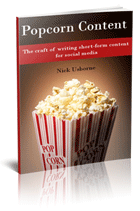
Popcorn Content – The craft of writing short-form content for social media.
Writing for social media is a whole new craft. Social media streams move quickly, so you have to hook your readers fast. But you also need to listen attentively…all of the time. And you have to engage with people.
This, my latest book, teaches you how to write this critically important type of content.
Popcorn Content is available on your Kindle, or the Kindle App for your computer or smartphone, for just $6.45.
Learn more about Popcorn Content
About the author: Nick Usborne is an online writer, copywriter, author and coach. Read more…
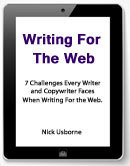
If you found this post helpful, sign up for my e-newsletter and get a free copy of my 35-page guide...
Writing For The Web #1 -- 7 Challenges every Writer and Copywriter faces when writing for the Web.
Sign up and I'll send you the link for the download, and then you'll receive my most recent post as part of my e-newsletter every Tuesday morning.
Sign Up for my Excess Voice Newsletter...
Name:
Email:
0 subscribers
We respect your privacy
Email Marketing by GetResponse
(Your email address will be used only for the purpose of sending you this newsletter, and you'll be free to unsubscribe at any time.)
June 13, 2015
The fastest way to learn about writing for the web is to have fun… while writing for the web.
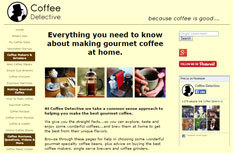 You probably remember this from your own time at school.
You probably remember this from your own time at school.
When you enjoyed the subject, and liked the teacher, you learned faster and did well. And the most enjoyable classes where those in which you were actually doing something rather than just studying a text book, line by line.
Long story short, you always learn more when you’re having fun. And what you learn sticks when you learn by “doing” instead of just reading text books.
The same is true when learning online writing and copywriting.
You can study all you want, but you’ll learn most when you “do it”, and when you’re having a good time.
Which brings me to my own favorite learning tool.
If you have read a few of my posts in the past, you probably already know I have a hobby website about coffee. It’s called CoffeeDetective.com.
I have been writing that site for 9 years now. And I do it because I enjoy it. I’m a bit of a coffee nut, and I like writing about making coffee.
As an added bonus, my coffee site also provides me with a nice passive income…several thousand dollars a month.
But the greatest value it delivers is as a teaching tool.
Over the last 15 years I have learned a great deal about online writing, copywriting and marketing. Some things I have learned from reading the work of other experts, and some I have learned through working with terrific clients.
But I have learned the most by writing my site about coffee.
How come? A couple of reasons.
First, because when I’m working on my site I’m learning by “doing”, and I’m enjoying myself. So what I learn sticks with me.
Second, everything I learn contributes to my broader understanding of online marketing.
Let me explain what I mean by that.
Imagine I write a product sales page for a client. It’s a great gig. And the new sales page I write does well. That’s terrific. But I haven’t learned much, because my involvement has been very narrow and fleeting.
Now let’s say I write a sales page on my coffee site, selling an ebook about making coffee.
First, I write the page. (Working on my sales page copywriting skills.)
Then I make sure it’s optimized for the search engines. (Learning more about SEO.)
If I can find or create an interesting image for the page, I’ll add it and then pin it to Pinterest. Maybe I’ll share that image on Instagram too. Or I could create a short video and upload it to my channel on YouTube, as well as embedding it on the page on my site. Then I’ll promote the page on Twitter, Facebook and Google+. (Learning about social media.)
Next, I’ll link to that new sales page from other pages on my site. (Internal link building.)
I could write several new content pages for my site that drive people forward to that sales page. (Content marketing.)
I’ll then follow the performance of every aspect of what I’m doing with my site’s analytics program. (Learning what works, and what doesn’t.)
Do you see the difference?
When I learn through book-learning or working with a client, my experience is focused, narrow and fleeting.
When I learn by working on my own website, the learning experience is broad, inclusive of many online marketing skills, and enduring.
All this to say that I have learned more about online writing, copywriting and marketing with my coffee website than I have from any other source. And it never feels like work or a chore, because when I work on the site I’m enjoying myself.
It’s a hobby with benefits.
You can do the same, on a topic that really interests you.
I know people who have written sites about topics as varied as rooftop gardening, watercolor painting, housesitting, aromatherapy, mountain biking and many, many others.
And a few thousand people have accelerated the process of getting their website online, attracting traffic and making money by taking my program, How to Write Your Own Money-Making Websites.
A lot of people who sign up for the program are attracted by the prospect of making a passive income by writing about a topic that already interests them.
I get that. I love the passive income part of this.
But I also highly recommend this for anyone who is trying to learn more about writing, copywriting and marketing online.
Writing your own website is the ultimate professional sandbox for writers. It’s where you can practice your skills, broaden and deepen your expertise, and learn for yourself what works and what doesn’t.
In addition, if your website topic is related to your niche as a professional writer or copywriter, your money-making website will become your ultimate “proof of competence” when looking for new clients.
For example, if your professional writing niche is in the field of natural health, you should probably choose a related topic for your own website.
That way, when a prospective client ask you for some evidence that you know and understand the natural health market, you can point to your website and say, “I’m writing to your market every day. I know your customers and what they want.”
OK…this is getting longer than I had planned.
But we now have three major benefits to writing a hobby website of your own.
1. Writing and creating your own website is the best and fastest way to learn about writing, copywriting and marketing online.
2. Your website will earn you a steady stream of passive income.
3. You can use your website as the ultimate brochure and “proof of competence” when talking with prospective clients.
If this sounds like a smart plan, and you want to get up and running as soon as possible, be sure to check out my program, How to Write Your Own Money-Making Websites.
About the author: Nick Usborne is an online writer, copywriter, author and coach. Read more…

If you found this post helpful, sign up for my e-newsletter and get a free copy of my 35-page guide...
Writing For The Web #1 -- 7 Challenges every Writer and Copywriter faces when writing for the Web.
Sign up and I'll send you the link for the download, and then you'll receive my most recent post as part of my e-newsletter every Tuesday morning.
Sign Up for my Excess Voice Newsletter...
Name:
Email:
0 subscribers
We respect your privacy
Email Marketing by GetResponse
(Your email address will be used only for the purpose of sending you this newsletter, and you'll be free to unsubscribe at any time.)
May 24, 2015
The broadcast medium formerly known as social media.
 Before it became commercial, the web was social.
Before it became commercial, the web was social.
By the late 1990s it was definitely more commercial than social.
Then, with the fast growth of dedicated social media channels like Facebook and Twitter, it became seriously social again.
The arrival of the smartphone in 2007 made the web even more social. Smartphones are, by definition, social devices. And many of the most popular apps for these devices are hard-core social.
And then...
And then social media became a commercial broadcast channel.
OK, that’s the short version.
To put it another way, while you and I still enjoy the truly social aspects of the web, both on our computers and our smartphones, companies and organizations are using “social media” as a broadcast channel to sell their products and services. They are rarely being social at all.
Go to the Facebook page of any large company or brand and you’ll find plenty of promotions but very little in the way of true conversation.
To be fair, I think a lot of companies started out on social media with good intentions. I think they wanted to be social. But found it just too hard.
Big companies and organizations have a lot of history to get past if they actually want to talk with their customers and really listen to them. They have a hundred years of ingrained habits that make the idea of actually being social something they find hard to fathom.
To compound the problem further, companies large and small are being sold tools and services that enable them to automate their social media. For example, a company can schedule a tweet or Facebook update a few weeks in advance.
Is that social? Hardly. It’s like scheduling what you’re going to say at a particular point at a dinner party that won’t take place for another two weeks.
How could your comment possibly fit into a conversation that hasn’t even started yet? It wouldn’t.
All this to say that I think social media experts and managers have lost their way.
They are using social media as a broadcast channel, not as a way to enter into real conversations.
The only people who are really being social on these platforms are regular people. Individuals. Not companies.
When I see something like this happening, I immediately think “opportunity”.
If companies are not being well served by the experts and tools they use now, it’s time to give them something different.
And my guess is that the best person to offer that kind of difference is someone like you. Why you? Because you’re a writer and a marketer, and you’re still living and working on a “human scale”. You still interact with others one-on-one, and not through automated systems.
I see an opportunity for a new breed of social media writers who approach companies and show them how to pull back from the broadcast model of social media and tap into the conversational model.
Would companies be receptive to that kind of approach? I think so, because I think a lot of companies also recognize that the broadcast approach to social media just isn’t working.
If I had the bandwidth to open up a second career for myself, I would be all over this.
If you do have the bandwidth, you might want to give the opportunity some thought. Social media marketing desperately needs help in getting back into the “human realm”.
NOTE: For foundational training in social media, and in what it means to be a social media writer, you might want to check out my program, How to Make Money as a Social Media Expert.
About the author: Nick Usborne is an online writer, copywriter, author and coach. Read more…

If you found this post helpful, sign up for my e-newsletter and get a free copy of my 35-page guide...
Writing For The Web #1 -- 7 Challenges every Writer and Copywriter faces when writing for the Web.
Sign up and I'll send you the link for the download, and then you'll receive my most recent post as part of my e-newsletter every Tuesday morning.
Sign Up for my Excess Voice Newsletter...
Name:
Email:
0 subscribers
We respect your privacy
Email Marketing by GetResponse
(Your email address will be used only for the purpose of sending you this newsletter, and you'll be free to unsubscribe at any time.)
May 10, 2015
Curiosity didn’t kill the cat. It fed the cat.
 I’m a pain in the behind when I first start working with a new company.
I’m a pain in the behind when I first start working with a new company.
I have a zillion questions I want to ask about their business and their marketing. And most of my questions reach out way beyond the scope of the project they want me to work on.
Why do I ask all these questions? Is it part of some cunning plan or process I use?
Nope. I ask them because I’m curious by nature. Business fascinates me. Marketing fascinates me. Business people and entrepreneurs fascinate me.
I read books about business and entrepreneurship.
I invite business people to lunch so I can find out what they are doing and what they are thinking.
It’s not about working smarter. It’s not about prospecting.
It’s just about being curious.
I imagine a few people have found me to be a little odd, annoying even, with my incessant questions. But for the most part, I’m pretty sure my curiosity has served me well, on a couple of levels.
On the first level, clients really like it when you are interested in their business, beyond the confines of the brief they gave you.
I have a friend who hires a ton of freelancers. The freelancers he likes working with are the ones who demonstrate their enthusiasm for his business. They’re not watching the clock and thinking just about getting the work done and sending in their invoice.
Sometimes they call him at odd hours of the day, weekends even, to ask him questions.
He loves that. He loves that they are excited by his business, curious enough to ask tons of questions, and then come up with new and unexpected ideas.
In other words, clients appreciate curiosity. It makes them feel you are truly engaged with their business, and keen to help them succeed.
On the second level, being curious will help you do better work.
When I approach a project with a curious mind, it drives me to think more deeply about the audience I’m writing to, as well as the product or service I’m promoting. I look at things with a fresh prospective. I become more involved. More deeply immersed in the task.
As a result, I write better copy.
All my best copy has been written for products or services that made me curious in some way.
In fact, I can’t even imagine working on a project that didn’t pique my curiosity.
I’m pretty sure that curiosity is an essential precursor to creativity.
And I know for myself that curiosity is a core motivator.
It’s what gets me out of bed in the morning.
Note: For help on how to launch or grow your freelance business, find out about my program for freelancers, Marketing Confidence.
About the author: Nick Usborne is an online writer, copywriter, author and coach. Read more…

If you found this post helpful, sign up for my e-newsletter and get a free copy of my 35-page guide...
Writing For The Web #1 -- 7 Challenges every Writer and Copywriter faces when writing for the Web.
Sign up and I'll send you the link for the download, and then you'll receive my most recent post as part of my e-newsletter every Tuesday morning.
Sign Up for my Excess Voice Newsletter...
Name:
Email:
0 subscribers
We respect your privacy
Email Marketing by GetResponse
(Your email address will be used only for the purpose of sending you this newsletter, and you'll be free to unsubscribe at any time.)
March 30, 2015
Why writing for the web is like driving a car in traffic.
 You’re driving downtown, in three lanes of traffic, during rush hour on a Friday afternoon.
You’re driving downtown, in three lanes of traffic, during rush hour on a Friday afternoon.
Your foot is jumping between the accelerator and the brake. Your eyes are looking out front, but also frequently checking the rear-view mirror.
And you’re in the middle lane, so you’re watching your wing mirrors and turning your head to check the blind spots.
In short, you’re moving forward, but constantly aware of everything that is happening around you, and adjusting how you drive accordingly.
And then...every now and again you’ll end up behind one of those annoying drivers who does none of these things, other than staring straight ahead. These bad drivers act as if they are completely alone on the road, without any regard to anything that is happening around them, with the exception of what’s right in front of their noses.
If I can hold the analogy together, the good driver represents a good online writer or copywriter. And the bad driver represents a bad online writer or copywriter.
Let’s look at the bad writer/driver first.
He sits down to write or rewrite a webpage, working hard but totally unaware of anything other than the one page he is writing. Like the driver who thinks he’s the only driver on the road, the bad writer acts as if he is writing a web page in isolation...that the page he is writing is the only page on the website.
He forgets, or doesn’t even consider that the page is just one part of a much larger, dynamic environment.
Let’s say it’s a second level page. So it’s going to be connected to the home page, and perhaps to other second level pages, and almost always to several third level pages.
Visitors are coming to that page from the homepage, other site pages, social media and direct links from elsewhere on the web. And they are leaving that page through a wide choice of links or “off ramps”.
In other words, a page is never just a single vehicle on a stretch of empty road. It’s part of something much bigger. Something that is connected, dynamic, fluid, and always very busy.
A good online writer or copywriter knows this.
He writes for readers who may have arrived through an internal link on the site, or from another site, or through a mention on social media. And so on. The page has to work for all of these audiences. He has to accommodate a variety of visitor expectations and intentions.
(I’m not talking here about landing pages that have been deliberately created for an audience from a specific email, PPC or social media campaign. This page is part of the permanent architecture of the site.)
He has to write the page knowing where he wants people to go next. At the end of his page, some readers will be ready to go directly to a sales page. Others will want more information first. Others are nowhere close to buying, but might be interested in reading a related page or signing up for the site’s e-newsletter.
Also, he has to be mindful of the fact that his readers are easily distracted.
If he doesn’t stay focused on the topic of the page, and he mentions things that aren’t directly relevant to its purpose, he may break the concentration and focus of his readers, and lose them altogether.
In other words, in the same way a good driver is constantly aware of everything that is happening around him, a good online writer or copywriter must be just as aware that the page he is writing doesn’t stand alone.
Every page on a website is connected, both internally and externally.
And every page has to be written in a way that it works well within this dynamic environment.
Never write a web page without being mindful of who is going to be reading it, where they might have come from, the intentions they may have, and the various places they might want to click through to next.
Always be the good driver when writing for the web.
NOTE: For professional-grade training in writing for the web, check out my program, Copywriting 2.0.
About the author: Nick Usborne is an online writer, copywriter, author and coach. Read more…

If you found this post helpful, sign up for my e-newsletter and get a free copy of my 35-page guide...
Writing For The Web #1 -- 7 Challenges every Writer and Copywriter faces when writing for the Web.
Sign up and I'll send you the link for the download, and then you'll receive my most recent post as part of my e-newsletter every Tuesday morning.
Sign Up for my Excess Voice Newsletter...
Name:
Email:
0 subscribers
We respect your privacy
Email Marketing by GetResponse
(Your email address will be used only for the purpose of sending you this newsletter, and you'll be free to unsubscribe at any time.)
March 17, 2015
Employees wait. Freelancers shouldn’t.
 As an employee of a company, you’ll often turn up for work and then wait to be told what to do.
As an employee of a company, you’ll often turn up for work and then wait to be told what to do.
That’s the nature of being an employee. You have supervisors and managers who draw up lists of what needs to be done, and then you get allocated items from that list.
I have worked with dozens of “newbie freelancers” who find it hard to shake off the habit of waiting.
They put up their website, do some promotion…and then they wait. They wait for someone to call them and offer them work.
Or they wait for a response to a bulk email they have sent out to dozens of prospective clients.
Or they make fifty cold calls, waiting for someone to say yes.
Always waiting…and acting as if they were still in that comfy cubicle.
Can you make a living as a freelancer by putting yourself out there and waiting? Possibly. But I wouldn’t recommend it.
I never wait. Not because companies line up to hire me, because they don’t.
I never wait because I can’t stand the insecurity of not knowing whether I’ll have any work to do next week.
So instead of promoting myself, asking for work, and waiting…I approach clients and prospective clients with ideas.
I don’t ask if they can give me work to do. I present them with a business idea I can help them with.
For example, I spent a little time socially with a business owner last fall. We have never worked together, but enjoy each other’s company. A couple of days later I had an idea. It was a service that could be bolted on the side of his existing business. He already has a list and a ton of engaged customers, and I figured a lot of those customers would want this new service.
I presented him with the idea, he liked it, and we’re nearly ready to launch. So far I have made a very small amount of money for a ton of work. But if the service takes off, I’ll do well from it, for a long time.
I did the same with another company a couple of years ago. Again, I didn’t ask for work. I gave them an idea we could develop together. In that case, I did a great deal of work for no money…and the project was shelved. That happens. Except in this case I got a call a couple of weeks ago, and we’re back on.
More recently, I was asked to write a standard sales letter for a company. The fee was attractive, and I like the people involved, so I said yes. And then I thought about it some more and got back to them with a whole new approach on how to tackle the project. It doesn’t involve a regular sales letter at all. Among other things, it involves flying one of their senior people to the other side of the world for 10 days. Crazy stuff.
There is a lot of extra work involved for me. But if it works, and I think it will, I should do well out of it.
Am I still a “freelance copywriter”? I am. That’s my core skill. But that’s not how I pitch myself. Because being a freelance copywriter usually involves waiting for someone to GIVE you work.
If what I have described so far sounds a bit “advanced”, don’t worry. You don’t have to come up with new business or service ideas to run your freelance business and your life like this.
I have a business friend who hires a lot of freelancers, and there is one guy he absolutely loves right now. Why? Because this freelancer keeps ringing him up at odd times, saying stuff like, “Jimmy, I’m sorry to call you at the weekend, but I just had this great idea!” Those ideas usually involve something simple, like a new headline, or a change to his copy approach, or maybe a new promotional item to try.
This freelancer really is still presenting himself as a copywriter. But he is proactive. He doesn’t wait for Jimmy to call him. He’s always creating new work for himself. He’s in the driver’s seat.
Waiting for work is hugely stressful. It makes you vulnerable. Over time, it makes you feel weak, and less able to do your best work.
Stepping forward with your own ideas is not without its own risks, but it’s a lot more fun, stretches your boundaries and can lead to some windfall profits.
Above all, it makes you feel more alive.
Just waiting doesn’t make you feel alive at all. It makes you feel like you’re living in a cubicle in your own home.
Note: While this article is largely about how I run my own freelance business, I wouldn’t have written it – or have even recognized myself as an “idea pitcher” - without inspiration from James Altucher’s excellent book, The Choose Yourself Guide To Wealth. Highly recommended.
Note #2: If you feel you lack confidence as a freelancer, find out more about my program for freelancers, Marketing Confidence.
About the author: Nick Usborne is an online writer, copywriter, author and coach. Read more…

If you found this post helpful, sign up for my e-newsletter and get a free copy of my 35-page guide...
Writing For The Web #1 -- 7 Challenges every Writer and Copywriter faces when writing for the Web.
Sign up and I'll send you the link for the download, and then you'll receive my most recent post as part of my e-newsletter every Tuesday morning.
Sign Up for my Excess Voice Newsletter...
Name:
Email:
0 subscribers
We respect your privacy
Email Marketing by GetResponse
(Your email address will be used only for the purpose of sending you this newsletter, and you'll be free to unsubscribe at any time.)
Nick Usborne's Blog
- Nick Usborne's profile
- 6 followers



